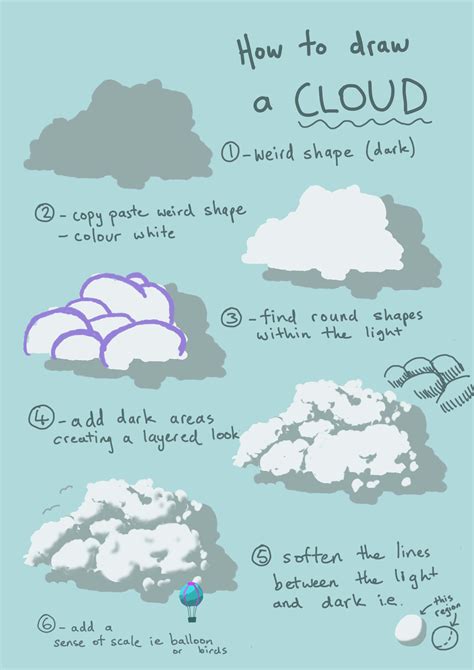How to Draw Clouds: A Beginner's Guide to Realistic and Artistic Cloudscapes
Drawing clouds might seem daunting, but with a little practice and the right techniques, you can create realistic and expressive cloudscapes. This guide will walk you through various methods, from simple shapes to more complex, textured clouds. Whether you're aiming for photorealism or a more artistic interpretation, this guide will help you master the art of cloud drawing.
Understanding Cloud Shapes and Formations
Before you start drawing, understanding the basic shapes and formations of clouds is crucial. Clouds aren't just fluffy white blobs; they come in a variety of shapes and textures, influenced by weather patterns and atmospheric conditions.
Common Cloud Types:
- Cumulus Clouds: These are the puffy, cotton-ball-like clouds often seen on sunny days. They are characterized by their distinct, rounded shapes and often have flat bottoms.
- Stratus Clouds: These are low-lying, layered clouds that appear as a gray sheet across the sky. They often bring drizzle or light rain.
- Cirrus Clouds: These are wispy, feathery clouds found high in the atmosphere. They are typically white and are made of ice crystals.
- Cumulonimbus Clouds: These are large, towering clouds associated with thunderstorms and heavy rain. They often have dark bases and anvil-shaped tops.
Essential Materials for Drawing Clouds
While you can draw clouds with practically anything, having the right tools can significantly improve your results.
- Pencils: A range of pencils (HB, 2B, 4B, etc.) will allow you to vary the darkness and shading of your clouds.
- Eraser: A kneaded eraser is ideal for lifting and blending pencil marks.
- Paper: Smooth or slightly textured paper works well for cloud drawings.
- Blending Stumps: These tools help to smoothly blend pencil strokes, creating soft transitions in your clouds.
Step-by-Step Guide to Drawing Clouds
Let's start with a simple cumulus cloud and progress to more complex formations.
Drawing a Simple Cumulus Cloud:
- Light Sketch: Lightly sketch the basic shape of the cloud using a light pencil (like HB). Think of rounded, puffy shapes.
- Shading: Use a darker pencil (like 2B or 4B) to add shading. The bottom of the cloud should be darker, gradually lightening towards the top. Remember that clouds are rarely uniformly shaded. Use varied pressure to create a sense of depth and texture.
- Blending: Use a blending stump or your finger to soften the edges of the shading and create a smooth transition between light and dark areas.
- Highlights: Add small, bright highlights using an eraser to create the illusion of light reflecting off the cloud's surface.
Drawing More Complex Clouds:
For more complex clouds like cumulonimbus or stratus clouds, you'll need to focus on creating a sense of depth and volume. Consider adding:
- Texture: Vary the density of your shading to create areas of light and shadow within the cloud.
- Perspective: Clouds appear smaller and less defined as they get further away. Consider this when creating depth in your cloudscape.
- Layers: Overlapping layers of clouds can add realism and complexity. Experiment with different cloud types and their interactions.
Tips and Tricks for Realistic Cloud Drawing
- Observe Real Clouds: Spend time observing real clouds in the sky. Pay attention to their shapes, textures, and shading. Take photos as reference.
- Practice Regularly: The more you practice, the better you'll become at drawing clouds.
- Experiment with Techniques: Try different shading techniques, such as hatching, cross-hatching, and stippling, to create varied textures.
- Don't Be Afraid to Make Mistakes: Mistakes are part of the learning process. Don't be afraid to experiment and try new things.
Beyond the Basics: Artistic Interpretations
Once you've mastered the basics of realistic cloud drawing, you can explore more artistic interpretations. Try adding color, experimenting with different mediums (like charcoal or pastels), or creating abstract cloud formations. The possibilities are endless!
By following these steps and practicing regularly, you’ll be creating stunning cloud drawings in no time. Remember to have fun and let your creativity flow!
